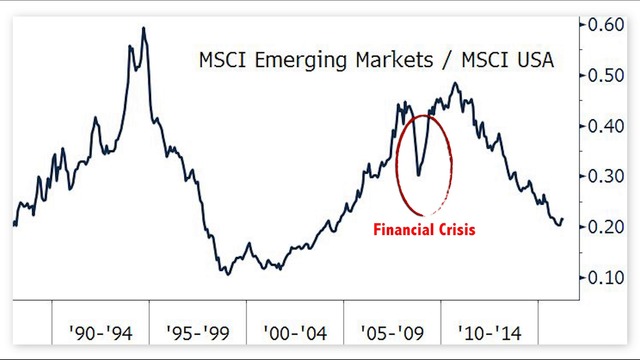Emerging markets are enjoying a strong rally, with the iShares MSCI Emerging Markets Index ETF (NYSE:EEM) up more than 20% since January 20, 2016.
This exchange-traded fund (which, by the way, is one of the most costly ways for investors to access emerging markets) tracks the MSCI Emerging Markets Index.
The index consists of 23 countries that represent 10% of world market capitalization, including Brazil, Russia, India, China, and South Africa, as well as Mexico, Greece, Qatar, Turkey, Malaysia, and the Philippines.
Factors supporting the rally include a dovish U.S. Federal Reserve, waning risks of a devaluation of the Chinese yuan, a sluggish but clear rally for oil prices, and tentative signs of stabilizing economic conditions in the U.S. and China.
The Middle Kingdom, however, may be the No. 1 factor: Chinese assets represent nearly a quarter of the weighting in EEM. South Korea and Taiwan account for 15% and 12%, respectively.
Russia and Brazil combine for 10%. India represents about 8%.
Brazil’s BOVESPA index, by the way, is up more than 40% this year.
That’s the on-the-ground view right now.
Wall Street Daily Chief Income Analyst Alan Gula – who pays close attention to China and its impact on the global economy for readers of his premium advisory The Shockproof Investor – provides a broader, more historical context in this week’s Saturday Spotlight.

The long view includes events such as the 1997 Asian financial crisis, the impact of the U.S. tech bubble, the early 21st century emerging market boom, and the Global Financial Crisis (GFC).
Emerging markets have underperformed in the aftermath of the GFC.
It’s tough to get too excited about this “relatively tiny” move in 2016. Many emerging markets are rallying off extremely low bases.
But, the way Alan sees it, “Emerging markets are, indeed, bottoming.”
We should be mindful of the caveats Alan enumerates.
At the same time, “Emerging markets, as a whole, offer a much better risk-reward proposition now than they did in 2011, when they were so popular.”
Around WSD
Wall Street Daily Chief Technical Analyst Jonathan Rodriguez focuses on stock charts, not balance sheets.
And he’s developed a proprietary system that identifies high-profit-potential trading opportunities.
Jonathan’s system is based on mathematics – ratios and patterns that inform the most complex of human endeavors, including priceless works of art and timeless architectural miracles.
Technical analysis isn’t the exclusive purview of “quants” and hedge funds. You too can make use of these profit-producing tools.
Jonathan’s surefire indicators are designed to help you protect the money you have – and to help you make more money.
This week, for Wall Street Daily, Jonathan chronicles a compelling opportunity to profit from the S&P 500 index’s recent breakout.
“On April 18,” Jonathan writes, “the S&P 500 not only broke its 11-month downtrend with force, but the resistance has now become support."
“This means that many new buyers will likely come into the market with the bullish strength to push stocks even higher.”
He also provides some useful insights into how not to play the breakout: “Don’t even think about buying the S&P 500 or an exchange-traded fund that tracks it.”
“Instead,” Jonathan suggests, “take a look at S&P 500 value stocks.”
Chief Income Analyst Alan Gula provides a timely diagnosis of what’s ailing Japan – “gargantuan deflationary pressures due to bleak demographic trends” – by way of explaining a “widowmaker” trade that “continues to confound traders and kill their capital.”
Alan does identify “a fantastic pairs trade” involving 10-Year U.S. Treasuries and Japanese bonds that also provides a hedge against a continuing decline in interest rates.
Senior Analyst Greg Miller is on the crime beat this week.
“If you like stories about daring bank heists,” he writes, “you’re gonna love this.”
“This” is the story of a daring break-in to the international payments system used for global interbank transfers using passwords of Bangladesh’s central bank.
Chief Technology Analyst Louis Basenese has a stark observation: “The last thing any investor should do is own Twitter Inc (NYSE:TWTR) into earnings.
“There’s nothing but pain involved.”
Want evidence? The share price of the social media sensation sold off to the tune of 16% the day after management reported results for the first three months of 2016.
And that, Lou notes, is “the seventh time in 10 quarters that shares sold off violently on the heels of quarterly results.”
And, no, this selloff does not translate into a buying opportunity.
Finally, Global Markets Analyst Martin Hutchinson surveys the wreckage of “YieldCo” SunEdison Inc, a once-promising marvel of solar and financial engineering that filed for bankruptcy on April 21, 2016.
“This event demonstrates the weaknesses of a business model dependent on renewable energy subsidies – especially when the subsidies have only just begun to lessen, never mind dry up altogether,” notes Martin.
In a broader sense, “It also demonstrates the folly of over-leveraged business models.”
Tread lightly around all things that appear too good to be true… particularly, however, when it comes to allocating your own investment capital.
